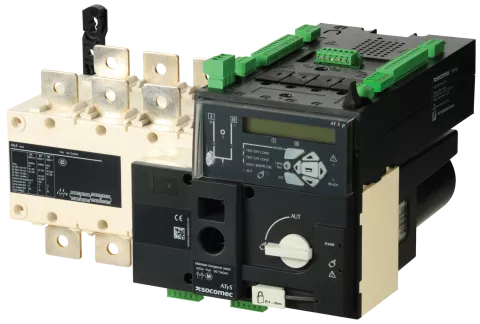What is an ATS?
Automatic Transfer Switches (ATS) are essential components in electrical power systems, especially when continuous, reliable power is required. Whether for critical infrastructure like hospitals, data centers, or industrial facilities, an ATS ensures that power is available without interruption. In this educational guide, we’ll dive into the features, advantages, applications, and technical details that make ATS units an invaluable part of power management systems.

What is an Automatic Transfer Switch (ATS)?
An Automatic Transfer Switch (ATS) is a device that automatically switches between a primary power source and a backup power source during an outage or failure. The main purpose of an ATS is to maintain power continuity by transitioning to a generator or alternative power source when the primary supply fails. This switching ensures minimal disruption and keeps essential equipment and systems running smoothly.
Key Features of ATS Units
Automatic Operation
ATS units automatically detect power loss from the primary source and initiate the switch to the backup power source. This eliminates the need for manual intervention and ensures that downtime is minimised, making it ideal for critical environments.
Three-Position Mechanism
ATS units typically have a three-position switch mechanism (I, 0, II), allowing for seamless switching between power sources. This mechanism, coupled with a motor-driven system, provides a smooth and reliable transition.
Solid-State Design
Unlike traditional electromechanical switches, ATS units often incorporate solid-state switching technology. This design reduces the risk of mechanical failure, leading to increased reliability and reduced maintenance requirements. The solid-state design also contributes to the robustness of ATS units, making them well-suited for harsh environments.
Self-Contained System
ATS units are self-contained, meaning they include all the components required for their operation. This simplifies installation and management, reducing the need for additional control devices. This feature makes ATS units particularly attractive for use in high-voltage (HV) compounds or remote locations where maintenance access is limited.
Location Flexibility
ATS units can be used in a variety of environments, including high-voltage areas and challenging settings such as outdoor installations or hazardous industrial facilities. Their robust design ensures that they can withstand tough conditions while providing reliable power switching.
How Does an ATS Work?
Monitoring
The ATS continuously monitors the primary power source for any fluctuations or failures. This involves assessing voltage levels, frequency, and other electrical parameters to determine the stability of the main power supply.
Detection
When the ATS identifies an issue with the primary power source—such as a power outage or significant voltage drop—it initiates the transfer process.
Activation of Backup Source
The ATS sends a signal to activate the backup power source, typically a generator or an alternate utility, ensuring it starts up and reaches operational status.
Transfer of Load
Once the backup source is ready, the ATS transfers the electrical load from the main power source to the backup source. This switch is executed through transfer mechanisms that safely and efficiently connect the load to the new power source.
Restoration
When the primary power source is restored and deemed stable, the ATS automatically switches the load back from the backup source to the main power source, ensuring a smooth return to normal operation.
For homeowners, this means essential appliances continue to function during power outages. For businesses, it ensures that critical systems remain operational, preventing costly interruptions and data loss. For electricians, it means delivering reliable, uninterrupted power solutions to customers.
Applications of ATS Units
Hospitals and Healthcare Facilities
In medical environments, power reliability is non-negotiable. ATS units ensure that critical equipment like life-support systems, diagnostic machines, and lighting remain operational during power outages.
Data Centers
Data centers rely heavily on continuous power to prevent data loss and hardware damage. ATS units seamlessly switch to backup power, ensuring that servers and storage systems remain online.
Industrial and Hazardous Locations
In environments such as chemical plants or oil and gas facilities, any interruption in power can lead to dangerous situations. ATS units are used to keep critical safety systems and process controls functional at all times.
High-Voltage Compounds
ATS units are ideal for high-voltage environments, such as electrical substations, where reliability and resilience are key. Their solid-state design ensures robust performance even under challenging conditions.
Advantages of Using ATS Units
Reliability
ATS units are designed to provide reliable power transfer without manual intervention. Their solid-state components contribute to lower failure rates and enhanced durability.
Safety
By automating the transfer process, ATS units reduce the risks associated with manual switching, such as human error or delays in power restoration.
Reduced Maintenance
With fewer mechanical parts compared to traditional electromechanical switches, ATS units require less maintenance, making them a cost-effective option for long-term use.
Scalability
ATS units can be scaled to meet the needs of various facilities, from small commercial buildings to large industrial complexes, offering flexibility in power management.
Challenges and Considerations
While ATS units offer numerous benefits, they do have some limitations. One of the primary considerations is cost. ATS units are significantly more expensive than contactor-based systems due to their sophisticated design and automation features. Additionally, the motor-driven switching mechanism, while reliable, is slower compared to the near-instantaneous switching that contactors can achieve. For applications where speed is the primary concern, a contactor-based system might be more suitable.
Wrap up time.
Automatic Transfer Switches (ATS) are indispensable in ensuring power continuity in critical applications. Their solid-state design, reliability, and automated operation make them the go-to choice for environments where uninterrupted power is essential. However, their higher cost and slower switching speed compared to contactors mean that they are best suited for applications where reliability and safety are prioritised over rapid transition.
Disclaimer:
The information provided on this site is for general informational purposes only and may not reflect the most current regulations or standards. Legislation, industry guidelines, and best practices can change over time, and it is the user’s responsibility to research and ensure compliance with the latest requirements for their specific situation. Always consult a qualified professional for advice tailored to your project or application.
